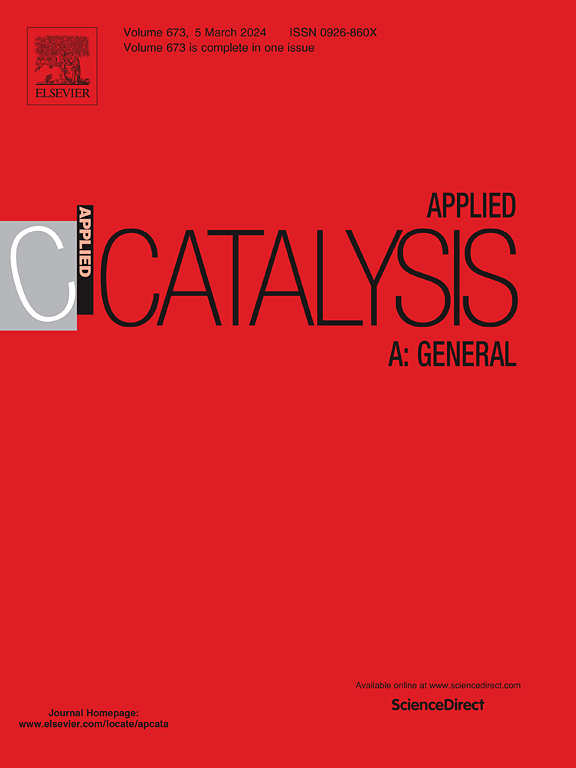聚苯胺衍生氮磷共掺杂碳负载钯金双金属催化剂的制备及对氯硝基苯选择性加氢催化性能研究
IF 4.8
2区 化学
Q2 CHEMISTRY, PHYSICAL
引用次数: 0
摘要
在植酸掺杂聚苯胺衍生的N/P共掺杂碳(NPC)载体上负载Pd-Au双金属纳米颗粒,制备了高效催化剂(0.05 %Pd-0.5 %Au/NPC)。系统评价了0.05 %Pd-0.5 %Au/NPC对对氯硝基苯(p-CNB)加氢制对氯苯胺(p-CAN)的催化性能。实验表明,微量Pd的加入显著提高了金基催化剂的转化率,同时保持了良好的选择性。NPC载体通过增强金属-载体的电子相互作用,优化了金属纳米颗粒的分散和表面电子态,使催化剂在100℃和1.2 MPa H2条件下,以良好的选择性(>98 %)实现p-CNB的完全转化。P掺杂导致金属表面出现缺电子态,促进了-NO2基团在P - cnb上的优先吸附和产物P - can的-NH2解吸,从而提高了催化效率。本文为开发高效环保的卤代硝基芳烃加氢催化剂提供了新思路,并为调控碳基贵金属催化剂中贵金属的电子结构提供了新方法。本文章由计算机程序翻译,如有差异,请以英文原文为准。
Preparation and catalytic performance study of Pd-Au bimetallic catalysts supported on polyaniline-derived nitrogen and phosphorus co-doped carbon for the selective hydrogenation of p-chloronitrobenzene
In this paper, an efficient catalyst (0.05 %Pd-0.5 %Au/NPC) was prepared by supporting Pd-Au bimetallic nanoparticles on a phytic acid-doped polyaniline-derived N/P co-doped carbon (NPC) support. The catalytic performance of 0.05 %Pd-0.5 %Au/NPC for the p-chloronitrobenzene (p-CNB) hydrogenation to p-chloroaniline (p-CAN) was systematically evaluated. Experiments demonstrated that the introduction of trace amounts of Pd significantly enhanced the conversion rate of the Au-based catalyst while maintaining good selectivity. The NPC support optimized the dispersion and surface electronic states of the metal nanoparticles by enhancing the metal-support electronic interaction, enabling the catalyst to achieve complete p-CNB conversion with a good selectivity (>98 %) under conditions of 100 °C and 1.2 MPa H2. The P doping induced an electron-deficient state on the metal surface, promoting preferential adsorption of -NO2 groups in p-CNB and desorption of -NH2 of products p-CAN, thereby improving catalytic efficiency. This paper provides a new strategy for developing efficient and environmentally friendly catalysts for the hydrogenation of halonitroaromatics and offers a novel method for regulating the electronic structure of noble metals in carbon-based noble metal catalysts.
求助全文
通过发布文献求助,成功后即可免费获取论文全文。
去求助
来源期刊

Applied Catalysis A: General
化学-环境科学
CiteScore
9.00
自引率
5.50%
发文量
415
审稿时长
24 days
期刊介绍:
Applied Catalysis A: General publishes original papers on all aspects of catalysis of basic and practical interest to chemical scientists in both industrial and academic fields, with an emphasis onnew understanding of catalysts and catalytic reactions, new catalytic materials, new techniques, and new processes, especially those that have potential practical implications.
Papers that report results of a thorough study or optimization of systems or processes that are well understood, widely studied, or minor variations of known ones are discouraged. Authors should include statements in a separate section "Justification for Publication" of how the manuscript fits the scope of the journal in the cover letter to the editors. Submissions without such justification will be rejected without review.
 求助内容:
求助内容: 应助结果提醒方式:
应助结果提醒方式:


